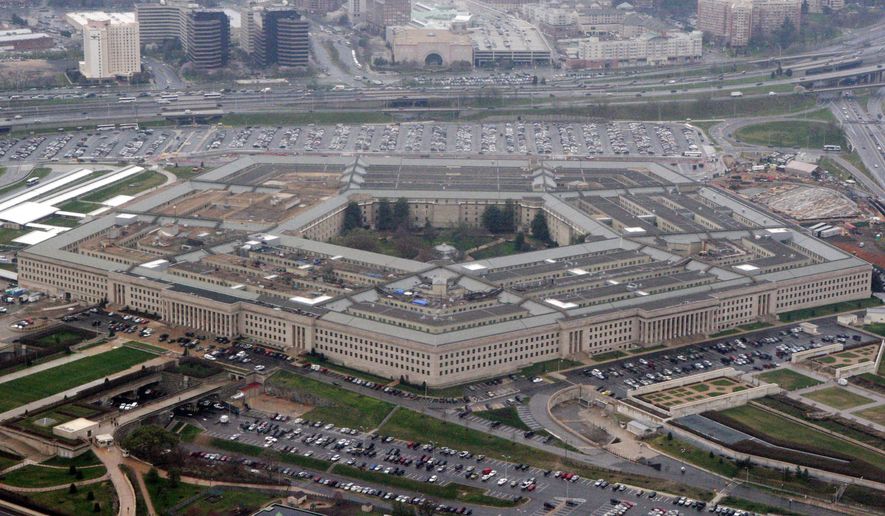Republicans are going to have to decide just how badly they want more defense spending.
With the House and Senate on track to finalize a budget later this month, they are facing another round in the long-running fight between defense hawks, who say the Pentagon needs more funding no matter the cost, and fiscal hawks, who say deficits must be constrained.
President Trump appears to have aligned with the defense folks, demanding a level of Pentagon spending that would breach the 2011 Budget Control Act, which created the budget caps and “sequesters” intended to get debt under control.
Democrats say any defense hike must be met with “parity” — meaning a dollar-for-dollar increase on domestic spending, further deepening deficits.
“You have to come up with a solution that meets all of their needs,” said Mark Cancian, a senior adviser at the Center for Strategic and International Studies. “The Democrats are not against an increase to defense. Where they draw the line is on domestic decreases.”
That creates a three-way standoff, with Democrats, as the biggest bloc, having a strong negotiating position.
SEE ALSO: Russia develops Iron Man-style armored suit: Report
The first decision for Republicans will be over the 2011 budget caps.
In the House, the defense hawks are winning. The budget approved last week and 2018 spending bills approved earlier this year blew through the Pentagon’s limit.
“Any budget negotiation must make the national security of our nation a top priority,” more than 150 House Republicans, led by Armed Services Committee Chairman Mac Thornberry, Texas Republican, said in a recent letter to President Trump.
They supported the president’s call for $700 billion in military spending — well above the projected 2018 limit of $549 billion.
Senate Republicans, however, are working on a budget that would stay within the defense cap.
Though Mr. Trump promised on the campaign trail to get the nation’s debt under control — even saying it could be wiped out in two four-year terms — he has since stepped back toward the defense hawks’ side of the debate.
SEE ALSO: U.S. military drone dominance challenged by enemies
“I know the president certainly does not want the caps on defense; he wants more defense spending,” said Rep. Peter T. King, New York Republican and former chairman of the House Homeland Security Committee.
“I think he’s going to fight harder than ever for more defense money,” said Mr. King. “But again, that’s what negotiating is — maybe we get more defense, they get more of something else.”
The domestic spending cap in 2018 is set at $516 billion.
It takes 60 votes in the Senate to change the 2011 law and lift the caps, giving Democrats significant leverage to cut an agreement with whoever is willing to deal with them.
“Being locked into these sequester caps is irrational, unreasonable and dangerous, on both the security side of the budget and on the nonsecurity side, which I would argue is equally as important,” said House Minority Whip Steny H. Hoyer, Maryland Democrat.
Mr. Thornberry also said recently at a Heritage Foundation event that he would like to end caps on both the defense and nondefense side. That is a break with most other Republicans, who want to maintain the caps or relax them only for defense.
Mr. Cancian said deficit hawks won’t agree to end the caps altogether. They attributed falling deficits and government spending in 2012 and 2013 to the strict discipline imposed by the caps.
“It’s very important to the deficit hawks,” he said. “They regard that process as a major accomplishment, and I don’t think they’re going to give it up.”
The 2011 law was set up to find about $2 trillion in cuts to try to move the federal budget back toward balance and to find a way to raise the government’s borrowing limit. About $1 trillion in reductions were projected over 10 years, divided between defense and nondefense programs, and a bicameral “supercommittee” was tasked with finding the rest.
The cuts were designed to be so painful for Republican defense hawks and for Democrats that it would force lawmakers to forge some sort of compromise. But lawmakers couldn’t come up with an agreement and now have to abide by even lower annual spending caps imposed by the law or trigger deep, across-the-board budget cuts known as sequesters.
“It’s a terrible way to budget. It did go into effect, and it has helped to keep discretionary spending relatively flat,” said Robert Bixby, executive director of the Concord Coalition, a group that advocates a middle-ground approach to tackling the nation’s debt.
But as will be the case this year, there are perpetual battles over the spending levels. Lawmakers have agreed multiple times to increase the caps and constantly hunt for other workarounds, such as a special war fund that doesn’t have the same budget constraints.
“You’re seeing it play out every year in the difficulty Congress has passing budgets and passing appropriations bills,” Mr. Bixby said.
One Republican solution has been to use gimmicks, such as shifting money that should be annual defense spending into emergency war-spending accounts, known as overseas contingency operations, which circumvent the budget caps.
Mr. Cancian predicted that lawmakers would try that again.
But Mr. Thornberry said he doesn’t want to do that.
“You could put a ton of money in OCO in defense, and you could get up to the levels I’m talking about without changing the caps,” Mr. Thornberry said. “But nobody thinks that’s a good idea, and I’m not advocating it.”
Mr. Thornberry said the caps have failed to rein in the real drivers of long-term spending: the major entitlement programs such as Medicare and Social Security.
“Remember, the purpose of the caps was to be such an ugly hammer that there would be entitlement reform,” he said. “Well, obviously they failed because none of that has happened.”
• David Sherfinski can be reached at dsherfinski@washingtontimes.com.




Please read our comment policy before commenting.